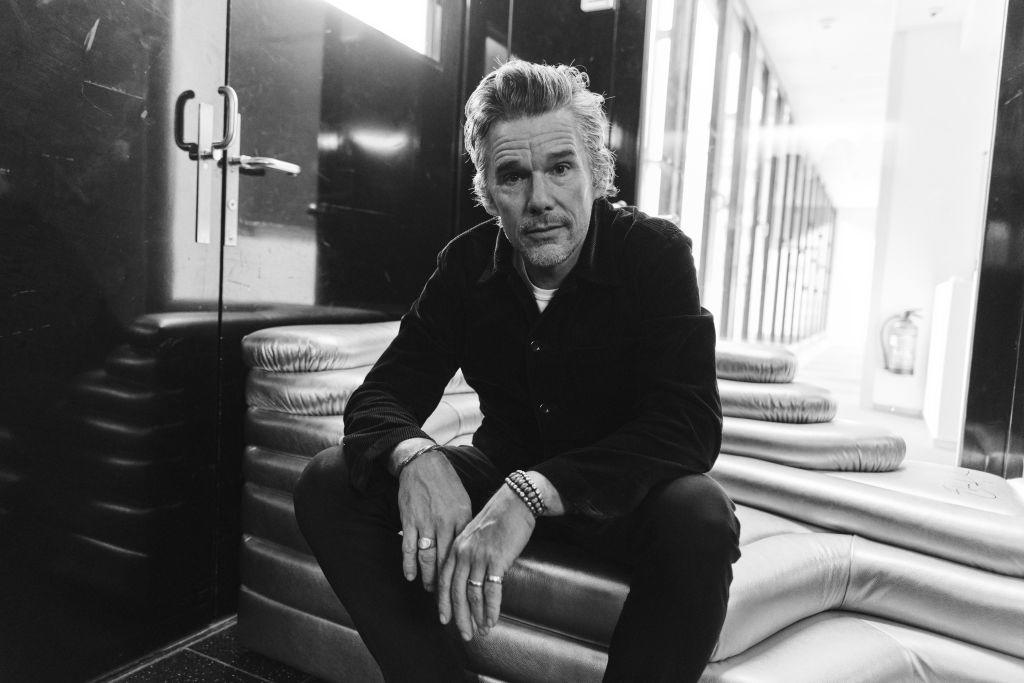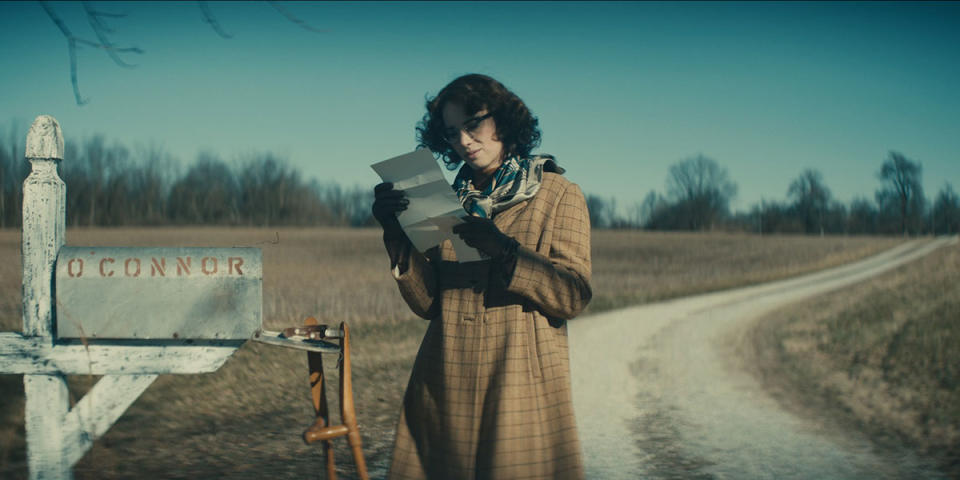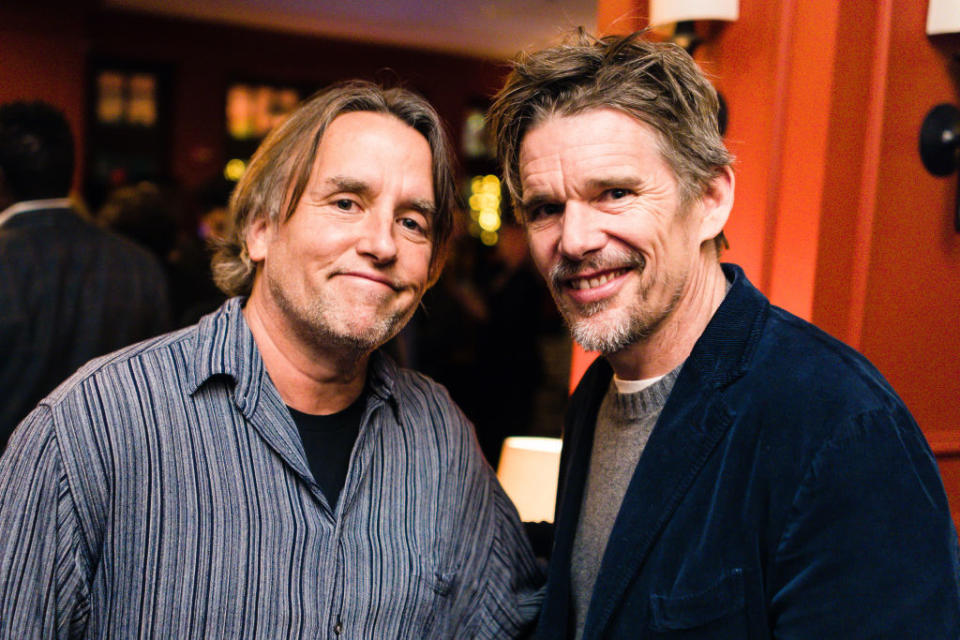How Ethan Hawke Unintentionally Became the Voice of Creativity

In March 2020, during the first days of the COVID pandemic, IndieWire launched an Instagram Live series. The idea was to hold a causal conversation with talent about their creative process and how they spend their free time, a discussion that took on a very different meaning against the uncertain backdrop of the lockdown. IndieWire instinctively turned to Ethan Hawke to launch the series and set the tone; and at a time when most creatives understandably went dark, Hawke was hungry for the conversation.
Later that summer, the actor-writer-director gave a TED-Ed talk, “Give yourself permission to be creative.” Even if you haven’t watched the nine-minute talk, you’ve seen it: Excerpts, four years later, still flood most social media feeds on a daily basis.
More from IndieWire
In the most viral clip, Hawke, discussing what happens to people when they suffer a great loss, said, “Did anyone feel like this before? What is happening to me? And that’s when art is not a luxury, it’s actually sustenance.”
With films like “Reality Bites” and “Before Sunrise,” in the ’90s, the actor came to define Gen X on the big screen. Now, in his fifties, he’s become the sage voice of the value of creativity on social media.
When Hawke was a guest on IndieWire’s Toolkit podcast to discuss his new film “Wildcat,” about young, yet-to-be-published Flannery O’Connor (his own daughter Maya Hawke) finding her voice as a writer, he somewhat begrudgingly acknowledged his new public persona online. “I know exactly what you’re talking about, but I don’t have any agenda or some theme,” said Hawke.
Rather, Hawke believes his interest and examination of the creative process is how he avoided career burnout.
“I think because I started so young, and because I’ve worked really hard to stay alive and stay curious,” said Hawke, 53, who became a star in his teens with films like “Dead Poets Society.” “There’s a certain amount of jadedness or bitterness that whenever you take something that has a possibility of being beatific, like self-expression, and you pimp it — you know, I pay for my doctor bills, my kids’ school, and put food on our table with it. This is how I make a living, right? You can get super jaded about it, and it can lose the fire that lit it in the first place. I’ve watched that happen so much that I’ve ended up spending a lot of time working on, ‘Well, why do I still want to do this?’”
While the motivation may have been creative self-care, Hawke himself has trouble denying it’s become a major theme in his own work.
“I was thinking about this the other day: I could do a little film festival on movies about arts,” said Hawke who, in the last 10 years alone, starred in “Maudie” about folk artist Maud Lewis; played jazz musician Chet Baker in “Born to Be Blue”; directed the biopic “Blaze” about country musician Blaze Foley; and made a documentary about a piano maestro Seymour Bernstein (“Seymour”); as well as the HBO docuseries “The Last Movie Stars” about actors Joanne Woodward and Paul Newman. “I did not foresee a theme here, but one is presenting itself to me [of] where my brain gravitates.”

“Wildcat” is a great example of how Hawke’s mind gravitates toward what sparks a creative mind. The project originated with Ethan’s daughter Maya who, after “Stanger Things” started to blew up, optioned O’Connor’s “Prayer Journal” and a few of the writer’s fiction stories, and asked her father to help develop them into a film for her to star, and him to direct.
“There’s something so remarkable about when your adult child wants to work with you, it feels like a victory somehow,” said Hawke. “They can choose to not be with you, and they’re choosing to be with you.”
And Hawke approached the material with this very practical POV: Write a role for his daughter. “If Maya had been 35, I probably would have done the end of [Flannery’s] life, right?” Hawke said. O’Connor died at age 39, 15 years after discovering she had Lupus and moved back home. “Maya wants to play this part at 24 years old, which is when she got the diagnosis. All right, let’s make a movie about that month [of her life].”
But as Hawke and his writing partner Shelby Gaines spent months marinating in O’Connor’s life right before she started writing her best works, Hawke was drawn to the way O’Connor simultaneously wrestled with her faith and creativity in her “Prayer Journal.”
“She was an incredibly devout person, and she found a way to pour her spiritual seeking into her creative life without proselytizing, without having an agenda about what the reader is supposed to do or say,” Hawke said of O’Connor. “It’s just her expressing herself, which I was really moved by. And I thought, Wow, if I could make a movie about the intersection between creativity, faith, and reality, and how those three things are integrated, well, that would be a very personal film for me.”
The film is also an exploration of the intersection of suffering and making great art. O’Connor’s physical decline, including her ability to travel, even walk, paralleled her development as a writer. Hawke was fascinated by how O’Connor believed she gained something from every loss. Asked of the relationship between suffering and great art, it’s clear it’s a question Hawke wrestled with during “Wildcat.”
“Richard Linklater, for example, one of the reasons why I love him so much is he’s a great artist, and I dare you to meet that guy and see him in a bad mood. It just doesn’t happen. The guy works from a place of joy. So it’s very possible,” said Hawke. “But I think you have to be very compassionate, very empathetic, and very well-read to push yourself to a depth of thinking that mortality forces. Flannery was shoved in the deep end of the pool.”

Hawke later added, “And so I think [suffering] elevated her thought. I do think that you don’t get something for nothing in this life. I mean, whether we’re talking about [Franz] Kafka or a lot of our great writers, they [were] forced into thinking in a less superficial way than most of us do.”
With “Wildcat,” there is obviously a fascination between a famous father directing his famous daughter, especially considering the examination of O’Connor’s life at age 24 is difficult material, including sex scenes (re-enactments of scenes in O’Connor’s fictional work). It’s material that many father-daughters might not want to work on together, but not surprisingly, the act of being creative is not a danger zone in the Hawke family.
“Every family has fault lines, places where you step where it’s dangerous, you touch an old wound,” said Hawke. “Maya and I have those, but the arts is our safe space. That’s where we’re both most comfortable and most comfortable with each other.”
“Wildcat” opens in theaters from Oscilloscope on Friday, May 3.
Best of IndieWire
The 13 Best Thrillers Streaming on Netflix in May, from 'Fair Play' to 'Emily the Criminal'
The Best Father and Son Films: 'The Tree of Life,' 'The Lion King,' and More
The 10 Best Teen Rebellion Films: 'Pump Up the Volume,' 'Heathers,' and More
Sign up for Indiewire's Newsletter. For the latest news, follow us on Facebook, Twitter, and Instagram.

 Yahoo News
Yahoo News 
